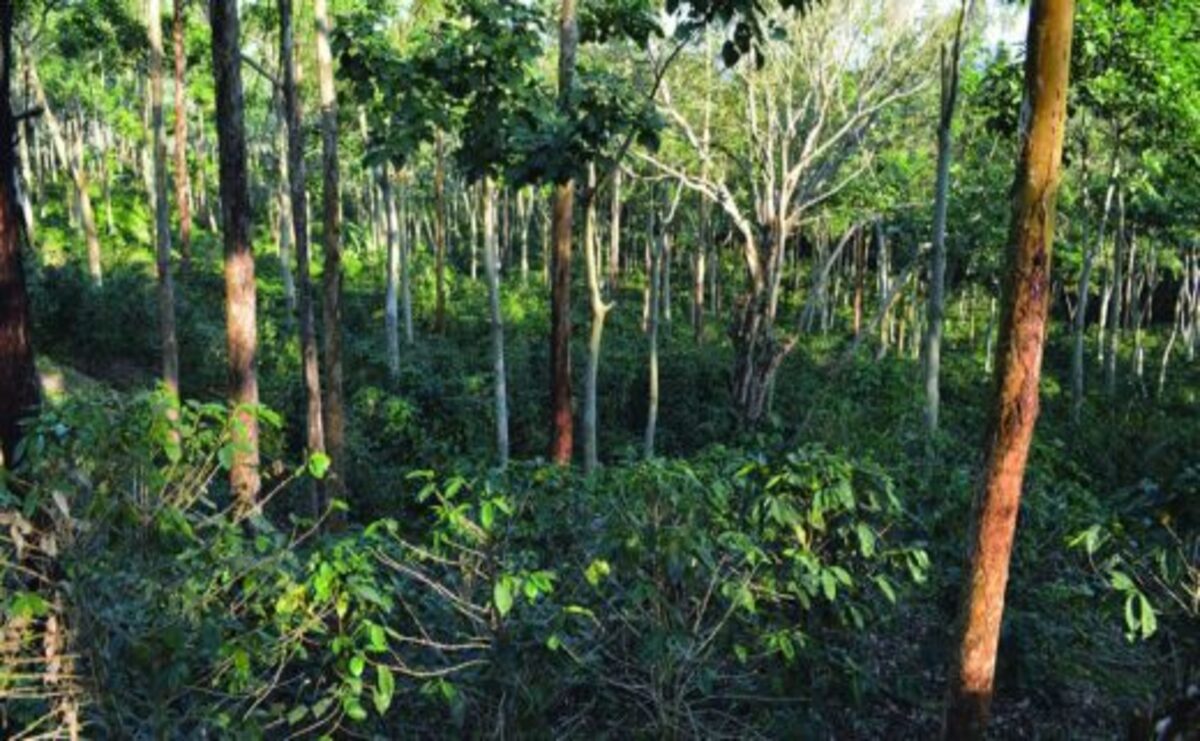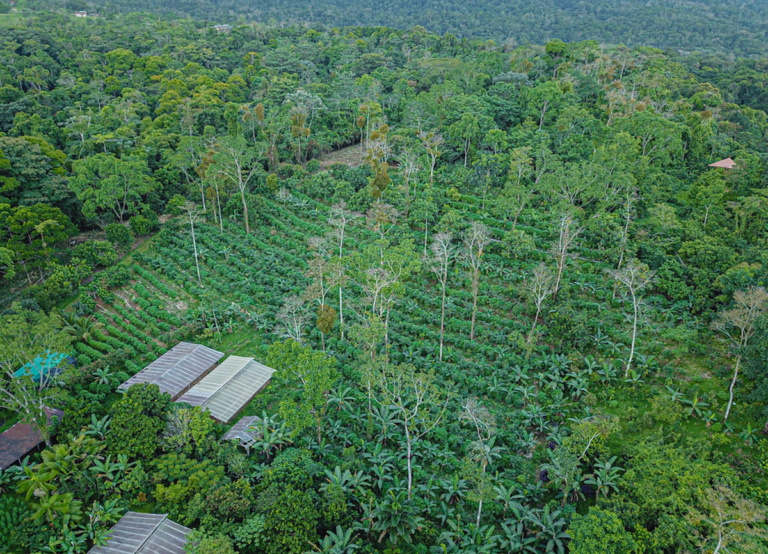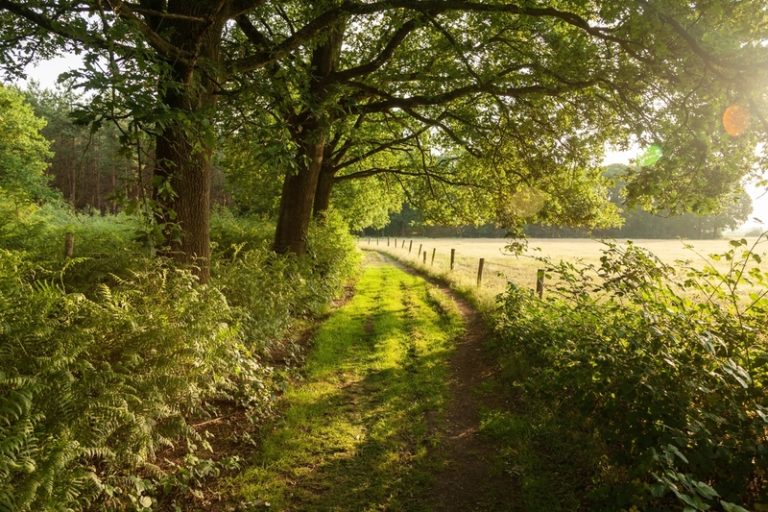Multistrata Agroforestry: A Sustainable Revolution in Farming Practices
The latest trend in farming is sustainable farming, and “Multistrata Agroforestry” is a great way to do it. It might sound complex, but stick with me, in this article we’re going to break it down into simple steps.
What is Multistrata Agroforestry?
Multistrata Agroforestry is like turning your farm into a small forest. Here instead of just growing one type of crop, you grow many layers of plants and even have some animals on the same piece of land . It’s like nature’s own teamwork.
Why Multistrata Agroforestry is so Important?
Multistrata agroforestry is important for many reasons because it solves many problems that standard farming methods have. Here’s why it’s so important:
Biodiversity Boost:
- In multistrata agroforestry, different kinds of trees and crops are planted together. The diversity works like natural environments to keep the farm’s flora high.
- An environment with more plant and animal is better and stronger. It supports bees, good bugs, and other animals, which helps keep the environment balanced.
Enhanced Soil Health:
- When plants are spread out over more than one layer, they all work together to make the soil healthier.
- Trees with deep roots help break up compacted soil so that water and nutrients can get through. This keeps the soil from washing away and helps it hold on to water.
- A diverse range of plants helps keep the soil’s microbiome in order, which lowers the risk of diseases and boosts the soil’s general richness.
Water Conservation:
- In some ways, Multistrata Agroforestry is like a natural method for managing water. Trees store and soak up water, which stops it from running off and washing away soil.
- The different kinds of plants also help keep the water cycle stable, which lowers the risk of storms and droughts. This is especially helpful in areas in which the weather is extreme or hard to predict.
Climate Change Mitigation:
- Trees are great at removing carbon dioxide from the air, which is called “sinks.” Integrating trees into farming systems is one way that multistrata agroforestry helps store carbon.
- By giving crops shade and lowering temperature extremes, this not only helps fight climate change but also makes them more resistant to its affects.
Economic Sustainability:
- Multistrata agroforestry farms can stay in business longer if they grow a variety of foods and make money from different sources.
- Since different products and crops can be picked at different times, the income is more stable throughout the year. This lowers the risk that comes with depending on just one crop.
Natural Pest Control:
- The different ecosystems that are produced by multistrata agroforestry automatically control the number of pests.
- Bringing good bugs and birds to the farm helps get rid of bad bugs, so chemical poisons aren’t needed as much. This supports a more sustainable and naturally balanced way of controlling pests.
Long-Term Sustainability:
- The goal of multistrata agroforestry is to last for a long time. Putting together different kinds of plants and animals makes a system that can take care of itself and needs less help from outside sources over time.
- Multistrata agroforestry helps the land stay healthy and productive over time by balancing the ecosystem and lowering its reliance on outside resources.
Agroforestry on multiple levels is important because it solves problems related to the climate, the economy, and society in agriculture, offering a complete and long-lasting way to grow food. It points the way to farming methods that are adaptable and regenerate, which are important for the health of both farmers and the earth.
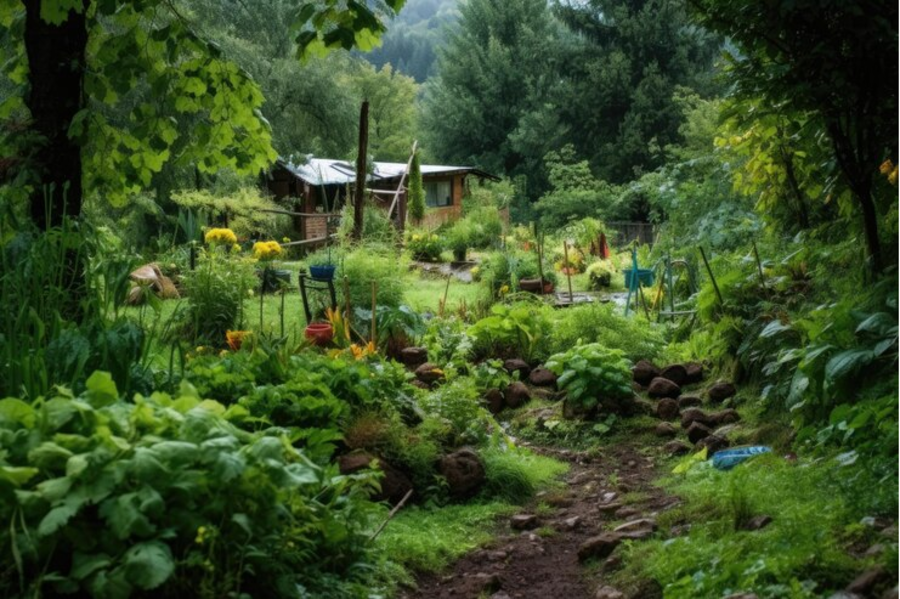
The Basics of Multistrata Agroforestry
Using Multistrata Agroforestry, you can make your farm’s environment more like a natural forest by connecting and varying the plants that grow there. The basics of multistrata agroforestry include essential components that make it work. Here are the most important parts:
- Tree Layers:
- Canopy Trees: This is the top layer, made up of big trees that provide shade and protection. They could be nut or fruit trees, like walnut or mango.
- Sub-Canopy Trees: There are smaller trees below the top layer. These trees add to the variety of the area and might include fruit or coffee trees.
- Crop Layers:
- Shrubs and Bushes: The plants in this layer are about medium-sized plants and are below the trees. Berries, herbs, and healing plants are some examples.
- Herbaceous Plants: Shorter plants, such as vegetables or cover crops, occupy the ground level. They make the soil healthier, add variety, and can be used for food or animal feed.
- Ground Cover:
- Low-growing plants or cover crops help protect the soil, reduce erosion, and provide additional biodiversity. There may be leguminous plants in this layer that fix nitrogen in the soil.
- Root Crops:
- Some root veggies, like sweet potatoes or carrots, can be added to the integrated, making the crops even more varied.
- Animal Integration:
- Livestock: It is possible to add animals to the system, like chickens, goats, or sheep. They help keep the soil healthy, keep weeds under control, and bring in extra money or food for the farm.
Key Principles:
- Companion Planting:
- Some plants do better when grown with others and can help each other out. For instance, plants that fix nitrogen can make the soil better for foods that grow nearby.
- Polyculture:
- Multistrata agroforestry supports growing more than one crop at the same time, instead of focusing on just one. This lowers the chance that the crop won’t grow and makes the system more resilient generally.
- Succession Planning:
- Learning about the different stages of a plant’s life helps you plan for steady yields. It may take longer for some crops to develop than others. With succession farming, you can be sure that you will always have food.
- Integrated Pest Management:
- Pests can be controlled naturally by beneficial insects that are drawn to a wide range of plants. This means that chemicals are not needed as much.
- Water Management:
- The structure’s layers help keep water from running off. Trees store water, which stops soil runoff and makes the best use of water.
- Pruning and Maintenance:
- To make sure trees grow properly, keep them from getting too crowded, and get the most out of the system, it needs to be maintained and pruned on a regular basis.
Farmers can set up and keep up a multistrata agroforestry system that is not only useful but also long-lasting and sustainable by following these basic rules and understanding the different layers.
Why Should Farmers Care for Multistrata Agroforestry?
There are many strong reasons for farmers to care about multistrata agroforestry and think about putting it into practice on their farms. This new and environmentally friendly way of farming has many advantages that affect the long-term success of farming operations, the health of the environment, and the output of farms. Multistrata agroforestry is important for farmers because of the following:
- Increased Biodiversity:
- Why it matters: Biodiversity is a key indication of an environment that is healthy. Multistrata agroforestry encourages different plant and animal to live together, making the landscape rich and varied.
- What farmers gain:By increasing biodiversity, natural pollination is supported, chemical inputs are cut down, and the farm environment becomes more robust.
- Improved Soil Health:
- Why it matters: A farmers’ success depends on having healthy land. Improves soil structure, fertility, and nutrient cycle with multistrata agroforestry.
- What farmers gain: Better soil health means more crops, less soil loss, and a growing system that can last longer.
- Water Conservation:
- Why it matters: Lack of water is a big problem in many places. Agroforestry on multiple levels helps keep water in the ground, stops it from running off, and controls the water cycle.
- What farmers gain: Better access to water for crops, lower chance of drought stress, and better use of water generally.
- Climate Change Mitigation:
- Why it matters: Changes in the climate make farming harder. As a natural way to fight climate change, multistrata agroforestry stores carbon dioxide and lowers the farm’s carbon footprint.
- What farmers gain: Climate change resilience, better farm sustainability, and possible possibilities for carbon credit schemes.
- Economic Sustainability:
- Why it matters: Having a number of income sources and lowering the risks that come with growing only one crop are both good for financial stability.
- What farmers gain: Better protection against changes in the market, more money coming in from different crops and products, and the chance to make money all year long.
- Natural Pest Control:
- Why it matters: Pests can hurt yields growth and make chemical treatments more necessary. Multistrata agroforestry helps keep pests away naturally by drawing good bugs.
- What farmers gain: Lower input costs, decreased dependence on pesticides, and a more ecologically balanced agricultural system.
- Long-Term Sustainability:
- Why it matters: Soil degradation and depletion of natural resources may result from the prolonged use of conventional agricultural methods. For long-term sustainability, multistrata agroforestry is designed.
- What farmers gain: Environmental sustainability, increased robustness, decreased reliance on external inputs, and the conservation of natural resources for humanity.
- Community and Environmental Impact:
- Why it matters: Local communities and the environment are benefited by multistrata agroforestry, which contributes to broader sustainability objectives.
- What farmers gain: A positive public perception, community support, and a sense of environmental stewardship.
Multistrata agroforestry is important to farmers because it provides a complete and long-lasting way to farm that solves many problems and has real benefits for both the farming community and the environment.
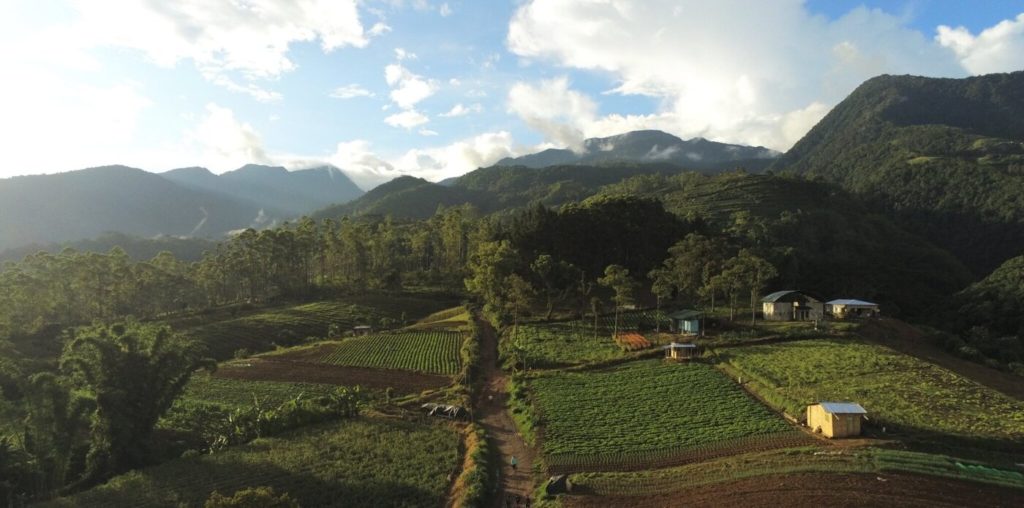
Setting Up Your Mini-Forest
A multistrata agroforestry system, also known as a mini-forest, needs to be carefully planned and thought out in order to be set up. Here is a step-by-step plan to help farmers set up their small forest:
- Site Assessment:
- Climate Considerations: Understand the local climate, including temperature, rainfall, and seasonal variations. Choose tree and crop species adapted to these conditions.
- Soil Analysis: Conduct a soil test to determine soil type, fertility, and nutrient levels. This helps you choose plants that will do well in the land you have.
- Topography: Consider the lay of the land, slope, and water drainage patterns. This information will guide the layout of the mini-forest.
- Selecting Suitable Tree and Crop Species:
- Indigenous vs. Exotic Species: To protect against invasive plants and increase biodiversity, plant and crop species that are native or well-adapted should be given priority.
- Companion Planting: Pick plants that go well with each other. Some plants help each other grow. For example, nitrogen-fixing plants make other foods grow faster.
- Planning for Long-Term Success:
- Succession Planning: Plan for steady results all year long by thinking about the different plant life cycles. By doing this, output gaps are avoided and space is used most efficiently.
- Risk Management: Find potential risks like severe weather or pest attacks, and come up with ways to lower these risks.
- Monitoring and Adaptation: Check on the mini-forest’s health often. Change the plan as needed based on what you see and how things are changing.
- Tree Planting Techniques:
- Proper Spacing: Place trees at the right lengths apart to keep them from getting too crowded. Think about how the trees will grow and how they will affect other plants’ ability to get sunlight.
- Pruning and Maintenance: Set up a cutting schedule to help trees grow in a healthy way and keep smaller plants from being shaded. Maintenance helps keep the whole system running smoothly.
- Crop Management Practices:
- Crop Rotation: Plan to rotate your crops to keep the land healthy and free of diseases that come from the soil.
- Interplanting Strategies: Mixing different crops in a way that makes the best use of space and helps all of them is recommended.
- Natural Pest Control Measures: Plant flowers and herbs that draw good bugs to help the environment. This naturally gets rid of pests that are bad for you.
- Livestock Integration:
- Grazing Patterns: Plan how your animals will move to keep certain places from becoming overgrazed. Grazing in cycles can be good for both the animals and the small forest.
- Animal Welfare Considerations: Make sure that letting animals live with people doesn’t hurt their health. Make sure there is enough cover, and think about how it will affect the environment as a whole.
- Learning from Others:
- Case Studies: Look at examples of multistrata agroforestry systems that work well. Learn from what other farmers have done, including the problems they had and how they solved them.
- Local Knowledge Sharing: Join farming groups, community groups, and agricultural education services in your area to share what you know and what you’ve learned.
- Community Engagement and Education:
- Raise Awareness: Teach the people in the area about the benefits of multistrata agroforestry. Get people in the neighborhood to help and participate.
- Training Programs: Organize training programs for farmers to learn about the principles and practices of multistrata agroforestry.
- Financial Support and Incentives:
- Explore Funding Options: Find ways to get money from environmental groups, government programs, or NGOs that support healthy farming.
- Incentives: Look for grants or rewards that will make it easier for people to use agroforestry methods.
- Advocacy for Policy Changes:
- Participate in Advocacy: Join or support initiatives that advocate for policy changes favoring sustainable and agroecological farming practices.
- Policy Engagement: Talk to local officials about promoting policies that support and encourage multistrata agroforestry.
By following these steps, farmers can create a mini-forest that not only helps them grow more crops, but also protects the environment and improves the health of the community.
Making It Happen on Your Farm
Multistrata agroforestry needs to be put into practice and managed on a regular basis for it to work on your farm. Here is a guide to help farmers use this method of growing that is good for the environment:
- Develop a Detailed Plan:
- Layout Design: Draw a plan that shows how the trees, crops, and other things will be placed. Take into account your farm’s terrain, how much energy it gets, and where the water comes from.
- Acquire Necessary Resources:
- Seedlings and Seeds: Find high-quality, varied seedlings and seeds of tree and food types that will grow well in your area.
- Tools and Equipment: Ensure you have the necessary tools for planting, pruning, and maintenance.
- Prepare the Land:
- Clearing and Weeding: Get rid of any useless plants and weeds in the assigned area. This gives the plants you picked the best chance to do well.
- Soil Preparation: According to your soil study, you should change the soil in your garden. If you need to, add organic matter to the soil to make it better.
- Tree Planting Techniques:
- Timing: When is the right time of year to plant trees in your area? Plant at the times that are suggested for each species.
- Planting Depth and Spacing: Plant trees at the correct depth and with sufficient spacing to allow for healthy growth.
- Watering: As the plant grows, make sure it gets enough water, especially in the first year.
- Crop Management Practices:
- Companion Planting: Follow companion planting principles to pair crops that benefit each other.
- Crop Rotation: To keep the soil healthy, plan and follow a crop rotation routine.
- Mulching: Use mulch to keep the soil wet, keep bugs away, and make the soil more fertile.
- Livestock Integration:
- Fencing: Put up the right fence to keep animals from moving around in the agroforestry system.
- Grazing Management: Rotational grazing can help stop overgrazing and let plants grow back naturally.
- Pruning and Maintenance:
- Regular Inspections: Check the crops and trees often for signs of pests, diseases, or lack of nutrients.
- Pruning Schedule: Make a pruning plan to keep the order you want and keep things from getting too crowded.
- Community Engagement:
- Education and Awareness: The people in the area should know about your multistrata agroforestry method.
- Field Days: To show off the benefits of your agroforestry methods, set up field days or farm trips.
- Adapt and Learn:
- Monitoring: Keep an eye on how well your multistrata system is working all the time. Watch how the different parts work together and make changes to your plan as needed.
- Adaptation: Be ready to change the way you do things based on what you’ve learned and how the world has changed.
- Celebrate Success and Share Knowledge:
- Harvest Festivals: Celebrate crops that go well with your community to show that multistrata agroforestry can work.
- Knowledge Sharing: Talk to other farmers about what you’ve done and what you’ve learned. You might want to join farmer trade programs.
- Explore Market Opportunities:
- Diversify Products: Try getting different things from your agroforestry system, like nuts, veggies, herbs, or goods that add value.
- Market Access: Identify local markets, cooperatives, or direct-to-consumer channels to sell your products.
- Sustainable Practices:
- Avoid Chemical Inputs: Minimize the use of synthetic fertilizers and pesticides to maintain the ecological balance of your system.
- Closed Nutrient Loop: Maximize nutrient cycling within the system by using organic matter from pruning and livestock.
By following these steps in a planned way, farmers can make their dream of a multistrata agroforestry system a reality, which will be good for their farm and the environment.
Challenges and How to Face Them
Using multistrata agroforestry can be hard at times, but farmers can get around these problems by planning ahead. Feel free to use these usual problems and solutions:
- Learning Curve:
- Challenge: Transitioning to multistrata agroforestry requires new knowledge and skills, and there may be a learning curve for farmers.
- Solution: Invest in education and training. Attend workshops, seek guidance from agricultural extension services, and collaborate with experienced farmers. Learning from others’ experiences can expedite the learning process.
- Initial Investment Challenges:
- Challenge: Setting up a multistrata agroforestry system might cost money at first because you’ll need to buy different plants, tools, and the equipment that the system needs.
- Solution: Find ways to get money by applying for grants, farming aid, or community funds. Some environmental groups and non-governmental organizations (NGOs) may help farmers who want to use more environmentally friendly methods.
- Regulatory Hurdles:
- Challenge: Some regions may have regulations that are not conducive to agroforestry practices, or there might be ambiguity in existing policies.
- Solution: Advocate for policy changes by engaging with local policymakers and environmental organizations. Join or support initiatives that promote sustainable agriculture and lobby for regulations that encourage agroforestry.
- Resistance to Change:
- Challenge: Farmers and communities may be resistant to change, especially if they are accustomed to traditional farming methods.
- Solution: Foster awareness and understanding through community engagement and education programs. Demonstrate the benefits of multistrata agroforestry through successful case studies and practical examples.
- Land Constraints:
- Challenge: Limited land availability may pose a challenge, especially for smaller farms or those with existing land use patterns.
- Solution: Optimize land use by selecting suitable, high-value tree and crop species. Consider integrating multistrata practices in existing fields or dedicating specific areas for agroforestry. Vertical gardening or intercropping techniques can maximize space.
- Market Access Challenges:
- Challenge: Finding markets for diverse products from a multistrata system can be challenging, especially if local markets are not familiar with or supportive of these products.
- Solution: Collaborate with local markets, farmers’ markets, and restaurants that value diverse and locally sourced products. Educate consumers about the benefits of multistrata products and explore direct-to-consumer sales channels.
- Maintaining Balance in the System:
- Challenge: Balancing the needs of different tree and crop species, as well as managing livestock, requires careful attention.
- Solution: Check the agroforestry system’s health on a regular basis. Put in place a well-thought-out management plan that includes when to prune, how to rotate crops, and how to handle animals properly. If you need help, talk to people who know a lot about farming.
- Community Engagement and Support:
- Challenge: Building community support and involvement can be challenging, especially if there’s a lack of awareness or interest in agroforestry practices.
- Solution: To bring more attention to the issue, hold neighborhood workshops, field days, and training programs. Stress the many advantages of agroforestry, including better health for the environment, higher adaptability, and business possibilities.
Farmers can successfully set up and maintain multistrata agroforestry systems by working together to solve these problems in a planned way. This will lead to a more adaptable and environmentally friendly way of farming.
Looking to the Future
Multistrata agroforestry has a lot of potential for the future when it comes to healthy farming, protecting the environment, and building strong food systems. Multistrata agroforestry is going to have a bright future thanks to a few important factors and trends:
- Global Adoption and Awareness:
- Trend: Growing awareness of the environmental impact of conventional farming is driving increased interest in sustainable practices like multistrata agroforestry.
- Future Outlook: As farmers, lawmakers, and customers become more aware of agroforestry’s ability to help with food security and climate change, it is likely to become more popular around the world.
- Technological Advancements:
- Trend: Integration of technology, such as precision farming and data analytics, is enhancing the efficiency and management of agroforestry systems.
- Future Outlook: Continued technological advancements will contribute to more precise planning, monitoring, and optimization of multistrata agroforestry, making it more accessible and productive.
- Research and Innovation:
- Trend: Ongoing research is uncovering new insights into optimal plant combinations, pest control methods, and sustainable management practices within multistrata systems.
- Future Outlook: Scientists and experts are always coming up with new ideas as they improve plant types, growing methods, and management plans that work in a variety of agroforestry systems.
- Collaborative Initiatives and Partnerships:
- Trend: Collaboration between farmers, NGOs, governments, and environmental organizations is increasing to promote and support agroforestry initiatives.
- Future Outlook: Local, national, and foreign groups will likely work together more to help farmers who use multistrata agroforestry by giving them money, resources, and places to share their knowledge.
- Climate-Resilient Agriculture:
- Trend: The unpredictable impacts of climate change are driving the need for resilient agricultural systems, and multistrata agroforestry is recognized for its climate-mitigating and adaptive capabilities.
- Future Outlook: Multistrata systems will play a crucial role in building climate-resilient food production systems, offering stability in the face of changing weather patterns.
- Policy Support and Incentives:
- Trend: More and more, governments and foreign groups are realizing how important agroforestry is for meeting sustainability goals. This has led to the creation of policies and incentives that support agroforestry.
- Future Outlook: Expect the formulation and expansion of policies that incentivize and facilitate the adoption of multistrata agroforestry, including subsidies, tax incentives, and regulatory frameworks.
- Education and Capacity Building:
- Trend: Educational programs and capacity-building initiatives are emerging to equip farmers with the knowledge and skills required for successful multistrata agroforestry.
- Future Outlook: Focusing on education and training will give farmers the tools they need to set up and run complex agroforestry systems well.
- Market Demand for Sustainable Products:
- Trend: Consumer preferences are shifting towards sustainably produced and locally sourced agricultural products, creating a demand for goods from agroforestry systems.
- Future Outlook: Multistrata agroforestry will contribute to meeting this demand, providing farmers with market opportunities and reinforcing the economic viability of sustainable agriculture.
The future of multistrata agroforestry looks bright, with plans for broad use, the merging of new technologies, collaborative projects, and a key part in creating resilient and long-lasting food systems. Multistrata agroforestry is a shining example of a more safe and natural way to farm in a world that is facing many environmental problems.
Conclusion
That’s all there is to know about Multistrata Agroforestry. It’s like changing your farm into a lively, joyful neighborhood where everyone has a part to play. Try it out—you might be the hero that the farm needs!
FAQ
Q: What is multistrata agroforestry?
A: Multistrata agroforestry is a sustainable farming system that integrates different layers of trees, crops, and sometimes livestock on the same piece of land, mimicking the structure of a natural forest.
Q: What are the key components of multistrata agroforestry?
A: It has layers of trees (canopy and sub-canopy), layers of crops (shrubs, bushes, and grass plants), ground cover, root crops, and animals are often added.
Q: Why is biodiversity important in multistrata agroforestry?
A: The agroforestry system is more stable when there is biodiversity. It helps keep pests away naturally, makes the soil healthier, and keeps the environment in order.
Q: How does multistrata agroforestry contribute to climate change mitigation?
A: In agroforestry systems, trees take in carbon dioxide from the air and store it as carbon dioxide. This helps slow down climate change.
Q: What challenges do farmers face when adopting multistrata agroforestry?
A: Challenges include a learning curve, initial investment costs, regulatory hurdles, and the need for community engagement. Overcoming resistance to change and ensuring market access can also be challenging.
Q: How can farmers overcome the learning curve of multistrata agroforestry?
A: Farmers can learn about multistrata systems by going to classes, getting help from agricultural education services, and hearing from other farmers who have used them successfully.
Q: What financial support is available for farmers interested in multistrata agroforestry?
A: To get money to do multistrata agroforestry, farmers can look into government funding, farming subsidies, and help from environmental groups or non-governmental organizations (NGOs).
Q: How can farmers optimize land use in multistrata agroforestry?
A: Farmers can get the most out of their land by choosing the right tree and crop species, using multistrata methods in current fields, and making the most of room by vertical gardening or intercropping.
Q: How does multistrata agroforestry contribute to water conservation?
A: The complex structure of trees and plants helps keep water in the ground, stops it from running off, and keeps water flows in balance.
Q: What role does technology play in the future of multistrata agroforestry?
A: Technology, like precision farming and data analytics, will help make multistrata agroforestry systems easier to access and more effective by making planning, tracking, and optimizing them more efficient.
Also Read :

